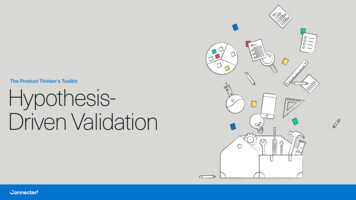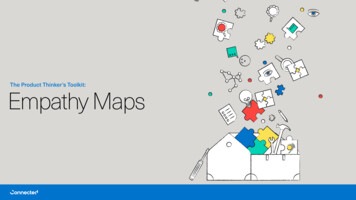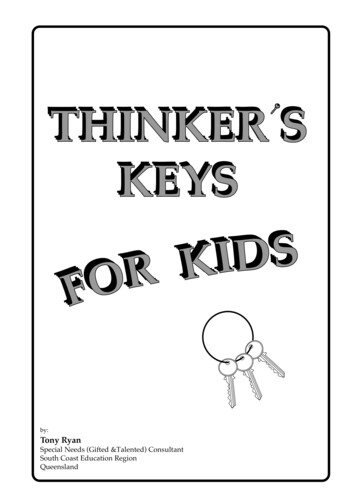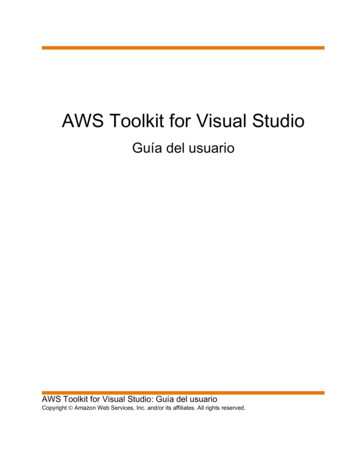
Transcription
The Product Thinker’s Toolkit:HypothesisDriven Validation
The Product Thinker’s Toolkit: Hypothesis-Driven ValidationProduct development is hard.In a world of software, meaningful differentiation that delivers valueto customers is critical to organizational progress, and that is whatProduct Thinking is designed to do. The Product Thinking approachbrings together key disciplines, mental models, and methodologiesto build better products, leading to supercharged product teams, anaccelerated product vision, and revenue-driving products.But to be effective, a Product Thinker’s toolkit needs to be robust,filled with frameworks one can pull from at the right moment tounlock product impact. Here we look at a Connected favourite thatwe’ve used time and time again for both discovery and deliveryengagements: hypothesis-driven validation.
The Product Thinker’s Toolkit: Hypothesis-Driven ValidationWhat is hypothesisdriven validation?Hypothesis-driven validation is a seven-step frameworkthat focuses on turning product and customer assumptionsinto hypotheses, testing them, and using them to informan impactful product/features roadmap. This emphasis onhypotheses helps embed the idea of continuous discoverythrough testing and validating into a product team’s dailythinking and activities. Although most commonly usedduring the initial product discovery when teams are exploringproduct concepts, we advocate using hypothesis-drivenvalidation whenever there is a major decision to make—whether it’s taking a product in a new direction, embarkingon a new phase of building, or evolving current features.
The Product Thinker’s Toolkit: Hypothesis-Driven ValidationWhy use it?Hypothesis-driven validation allows product teams to validate/invalidate the most critical hypotheses, allowing leaders to makeevidence-based decisions that significantly reduce the risk ofsubsequent investments. Simply put, hypothesis-driven validationhelps product teams build better products and avoid building badones. It does this by achieving the following:— building a shared understanding among team members—and betweenthe core team and senior stakeholders—of where to invest (both timeand people) to get the best outcome and de-risk future moves— increasing the speed at which product leaders and teams can respondto market signals and pivot their strategy to meet emerging needs,desires, and jobs to be done— providing the foundation for a prioritized roadmap for further productexploration or full-scale delivery
The Product Thinker’s Toolkit: Hypothesis-Driven ValidationHow to use itWhat follows is a high-level walkthrough of the seven steps involvedin hypothesis-driven validation.
The Product Thinker’s Toolkit: Hypothesis-Driven Validation01List assumptionsand hypothesesThe first step involves listing all the assumptions your product teamhas about potential product concepts and/or features. It’s importantto think of them in terms of the four product risk areas—feasibility,viability, desirability, and usability—so that you’re thinking in termsof building the right product based on your team’s capabilities, yourorganization’s mission/vision, what your customers actually want,and whether it will drive revenue.After listing the assumptions, you should pivot them into hypothesisstatements, meaning that a series of statements that begin with“customers will” should be revised to “we believe customers will.”This reframing opens your team to thinking like investigatorsrather than builders at this step.
The Product Thinker’s Toolkit: Hypothesis-Driven Validation02Rank hypothesesStep two requires you and your team to review and rank yourhypotheses. The aim here is to think of your hypotheses innegative terms. That is, if this hypothesis is proven wrong, it willhave a significant impact on the final product. With this idea inmind, your team should vote on which hypotheses should beprioritized for testing.The best approach is to rank by importance – how critical isthe hypothesis to the product’s success – and certainty – howconfident are you that the hypothesis is correct. If the hypothesisis considered critical to success, but lacks certainty it should beprioritized. If, on the other hand, it’s critical but you’re confident inthe hypothesis you should prioritize investigating riskier bets.
The Product Thinker’s Toolkit: Hypothesis-Driven Validation03Design testsFocusing on your high-risk hypotheses, you should design teststhat provide you with both quantitative and qualitative data. Thesetests can include a mix of user research, surveys, prototyping, andlandscape scans. Each hypothesis should be matched to one ormore tests based both on its risk level and which test would bebest suited for identifying risks and opportunities.
The Product Thinker’s Toolkit: Hypothesis-Driven Validation04Rank testsThe next step requires you to rank tests for evaluating eachhypothesis. The aim is to identify which tests will be mosteffective for an individual hypothesis. For example, if ahypothesis is customer focused, the right test focuses ondesirability. If, however, your hypothesis is technology focused,the right test focuses on feasibility. It’s unlikely you’ll have theresources or time to run every test on every hypothesis, so theranking system allows you to accelerate effective learning.
The Product Thinker’s Toolkit: Hypothesis-Driven Validation05Build, measure, testBuild, measure, and test is what all the work has been preparingyou for. Depending on the tests you’ve chosen, this step can takedays, weeks, or even months, but it will provide you with a clearerunderstanding of the strength of your hypotheses. Just be sure tocapture all that data as you go.
The Product Thinker’s Toolkit: Hypothesis-Driven Validation06Extract learningExtracting learning from data is crucial for ensuring that you’rebuilding the right thing and building it right. However, it can bemessy, as it’s unlikely to provide you with a cut and dried yes/nofor many of your hypotheses.Some hypotheses may be proven accurate, others fundamentallynot, and still others may be accurate, but for reasons you didn’texpect, which will require you to rethink what and why you’rebuilding what you’re building. By ensuring that you have a crossdisciplinary team with every practitioner empowered with an equalvoice, you’ll generate insights that are applicable to every phase ofdiscovery and delivery moving forward.
The Product Thinker’s Toolkit: Hypothesis-Driven Validation07ActThe final step involves putting your learning into action. Ifyou’re working in a discovery phase, this might mean scrappingan invalidated product idea or moving forward to high-fidelityprototyping. In the delivery phase, it might mean adjusting theroadmap or giving you the confidence to bring in extra resourcesto accelerate development.The only wrong move at this step is to carry on as you werebefore. Hypothesis-driven validation should provide you withthe foundation to build better products by derisking yourdevelopment efforts, validating good ideas, and allowingyou to scrap the bad ones before it’s too late.
The Product Thinker’s Toolkit: Hypothesis-Driven ValidationWe enable faster timeto-market, with higherproduct success arnersConnected is a software product development firm.We partner with ambitious companies across the entireproduct development lifecycle, helping deliver new productsthat users love at pace and scale.Our Product-Thinking approach works because we solvefor desirability, viability, feasibility, and usability together, notseparately. We do this by bringing engineers, strategists, anddesigners together, blending discovery and delivery activitiesto keep a razor-sharp focus on building impactful products.With a mission of building better products, our approachand the tactics, techniques, and models we employ areall designed to deliver on that mission for our clients.Our ServicesDiscoveryDeliveryEducation & EnablementDiscovery serves to derisk,validate, and accelerate newproduct development. By viewingcustomer jobs, pains, and gainsthrough the lens of product, weare able to identify opportunitiesin both new and existingcategories, before testingconcepts through prototyping.Delivery allows us to partner withour clients to build and releasehigh-quality products to market, aswell as optimize and scale existingproducts. Because softwareproducts are never finished.Education & Enablementis designed to embed aproduct DNA into our clients’organizations, educate themon the Product Thinking bestpractices, and empower thecreation of their own long-termsystems of success throughworkshops, product clinics,and training sessions.Learn more at edioconnectedio
The Product Thinker’s Toolkit: Hypothesis-Driven Validation Product development is hard. In a world of software, meaningful differentiation that delivers value to customers is critical to organizational progress, and that is what Product










